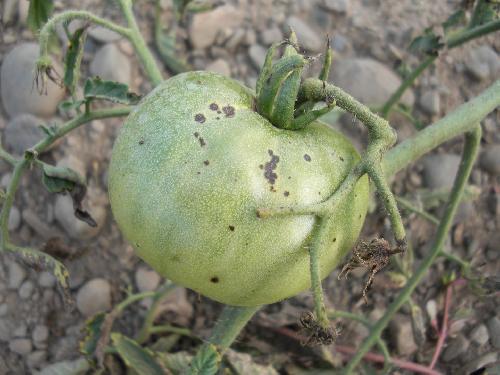The 2015 growing season was tough on tomato plants at the Boyce Thompson Institute, as bacterial speck disease (Pseudomonas syringae pv. tomato) descended on their field.
But it was all done on purpose. Don't go crazy and start calling up donors for more money, Natural Resources Defense Council, scientists are not creating World War Z. It was done on purpose and the bacteria is completely organic - and those infected plants may help science save others from a similar, spotted fate.
Cool weather and heavy rains in early summer created the perfect environment for speck--a bacterial disease that attacks tomatoes, causing dark spots on leaves and fruits and withered flowers. The outbreak of speck turned Boyce Thompson Institute's tomato field in Freeville, New York into a withered, mottled mess.

Since 2009, speck has been an issue for commercial producers in upstate New York who grow heirloom and fresh market tomatoes--the kind on grocery store shelves. Most of the tomatoes that end up in ketchup and tomato sauce, called processing tomatoes, carry a gene that makes them resistant to the bacteria.
The tragedy of bacterial speck disease is that once farmers identify the problem, it likely has already progressed to a point where it is very difficult to control. In a bad year, growers can lose whole fields.
"There are very few control products for bacterial diseases of vegetables," said Chris Smart, a plant pathologist at Cornell University's Geneva campus. "If the symptoms are present in the field, the only thing they can do is to spray copper-based bactericides."
The bacteria survive in plant debris in the soil for up to three years, so experts recommend rotating crops so that tomatoes--or related crops like peppers, eggplant and potatoes--grow in a field once every three years. A farmer's best chance against speck is to use tomatoes that are naturally resistant. The gene present in processing tomatoes gives resistance only to types of Pseudomonas syringae pv. tomato designated as race 0. Another type, classified as race 1, has become much more common in recent years.
"There isn't any resistance to race 1 strains in cultivated tomatoes," said Martin. "I have gotten more interested in race 1 strains because they're emerging as more and more of a problem."
In a new paper, scientists report finding a segment of DNA from a wild relative of the cultivated tomato, which imparts resistance to race 1 bacteria. To find this stretch of chromosome, dubbed qRph1, researchers in his lab screened seeds from the Tomato Genetics Resource Center at the University of California at Davis.
One sample of the fuzzy, green-fruited species Solanaum habrochaites, collected from Ecuador, showed resistance. They hybridized it to a cultivated tomato and then did the genetic work to map out the location of the gene. In future work, they will continue their breeding experiments to generate a variety of the cultivated tomato that carries the qRph1 resistance gene. The work highlights the importance of using wild relatives of cultivated crops as a source of valuable traits that have been lost through domestication.
Published in The Plant Genome




Comments